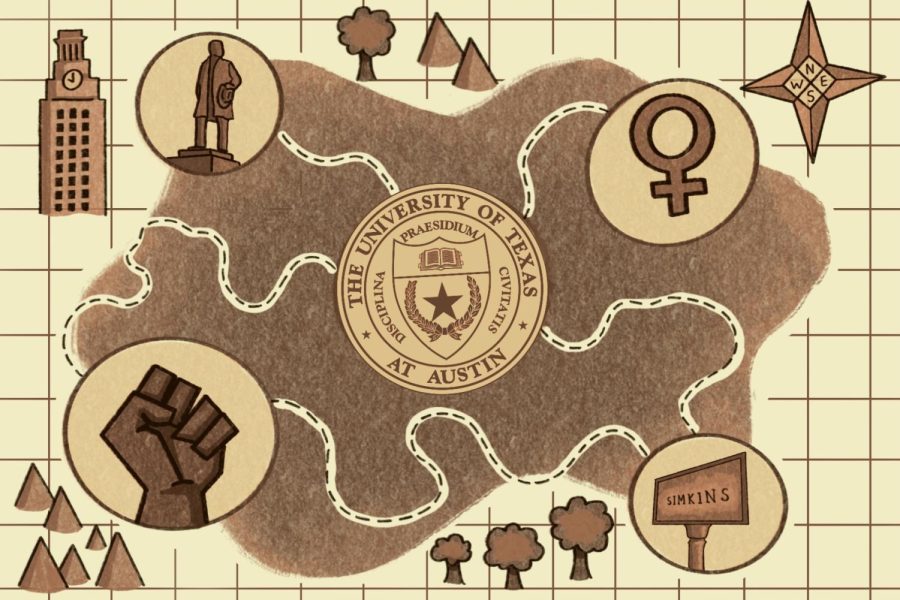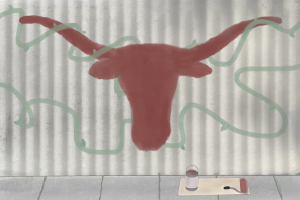UT’s geography has intrinsic ties to race and gender
April 18, 2023
The environment we reside in undeniably influences our interactions with the structures and people around us. For example, UT’s geography highlights the history of on-campus power struggles and the progress for which our community fought. While the University’s core curriculum forgoes these topics, understanding how our campus’s architecture connects with the community is vital for change-making today.
Fortunately, there are existing, comprehensive resources – like the Racial Geography Tour – that we can leverage to educate ourselves on this subject.
“The Racial Geography Tour began as a walking tour of The University of Texas at Austin’s campus. What began as lectures about UT’s Black history turned into a more sustained research project about the broader racial history of the University — an approach less taken,” the tour’s website says.
The digitized tour was created through a collaboration between professor Edmund Gordon, UT research associate Celeste Henery, electronic publishing specialist Asha Thompson and consultant Daniel Garza.
Racial geography tours are crucial to students’ experiences. When universities don’t openly discuss their racial histories, administrations promote institutional distrust in student bodies.
“My dissertation research looked at the ways in which college students navigated the socio-historical context of race and campus,” said Maureen Flint, assistant professor of qualitative research at the University of Georgia in the Mary Frances Early College of Education. “Students were aware of the history of race, and when the university did not tell that story that history became almost … illicit.”
Acknowledging this history gives students a solid foundation on which to build their educational experiences.
“When students feel a greater sense of belonging on campus, they’re more likely to succeed on campus, they have better student outcomes,” Flint said. “Often the ways that we look at belonging is absent of place and history, but that matters.”
Regardless of your major or identity, UT’s campus history influences your positionality at the University.
“(Campus geography is) extremely important for people to know because it’s subconscious ways that we’re being directed because of our history,” said Lazarus Om, a communications and leadership sophomore and member of the Chickasaw Tribe.
While it may be difficult to reckon with particularly abhorrent historical events, talking about them creates the potential for progress.
“I think these racial tours changed my view on UT negatively, because I learned about UT’s actions in the past, but I also know that UT has the capability of changing and I hope that they do,” Om said.
UT’s Racial Geography Tour helps students feel more at home on campus. Below are some key sites the tour explores:
Originally, the honors quad housed only three dorms: Littlefield, Carothers and Andrews Hall. The trio faced the Anna Hiss Gym and were constructed with traditionally “feminine” architecture to create a separate space for women. Farther down the street, Whitis Hall and Almetris Co-op – two now-discontinued buildings – once housed Black women until the University ended segregation.
Painter Hall was named after University President Theophilis Painter, who acted as the University’s representative in the 1950 Supreme Court case Sweatt v. Painter. In 1946, Heman Marion Sweatt was denied admission to Texas Law based solely on his race, but he challenged this decision in court. While the Supreme Court’s decision granted Sweatt access to UT, Painter Hall bears the name of a racist individual who championed Sweatt’s rejection. Understanding that the building is named after someone on the wrong side of history is important to contextualize UT’s past.
Situated at the base of the UT tower, South Mall is not as accessible as the West Mall. South Mall was constructed during the unrest of the 1960s and 1980s to control the flow of unruly students or crowds onto campus grounds. Furthermore, the old women’s campus remains concealed by the UT Tower and reflects women’s role in the private sphere at the time. As a masculine symbol, the Tower embodies a gendered seat of power.
Right Side of Littlefield Fountain
The Littlefield Fountain statues were designed by former Confederate officer George Littlefield and Italian sculptor Pompeo Coppini. The statues embrace the ideals of liberty and victory in connection to U.S. manifest destiny. They represent the nation’s military might, and some even symbolize classical republicanism.
“It is an intensely militaristic, patriotic, and white nationalist tableau, which celebrates the ways in which the new South is re-emerging as an important part of this white supremacist nationalism,” the tour said.
Muthukrishnan is a government and race, indigeneity and migration freshman from Los Gatos, California.















